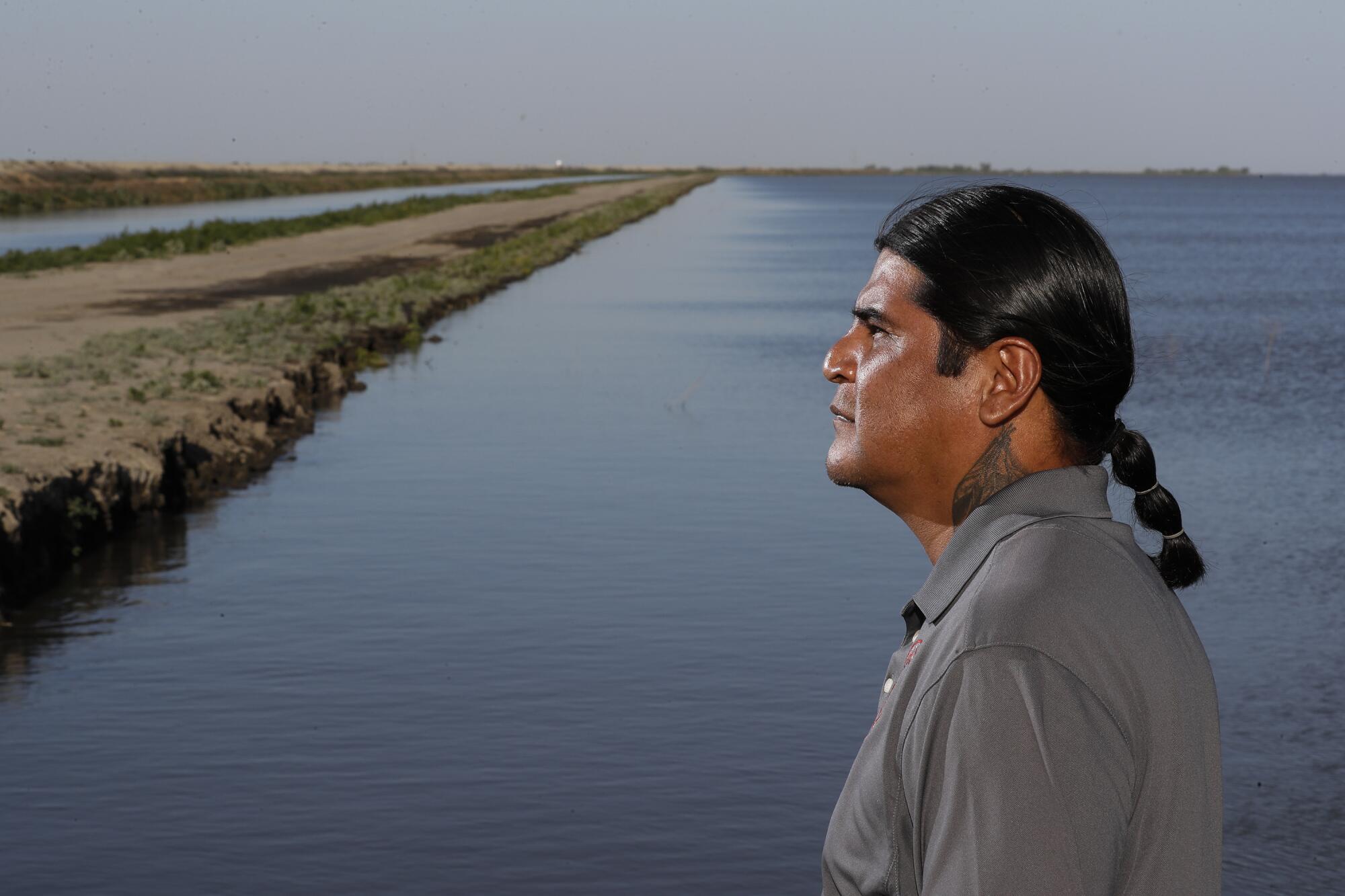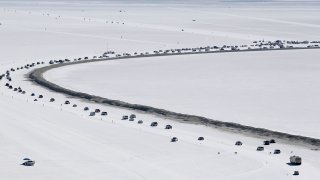Farmers emptied Tulare Lake over a century ago, and it has only sporadically resurfaced in the San Joaquin Valley when floods have restored farmlands along the lake’s old bed.
A group of environmentalists, community activists, and tribal elders have now joined forces to try to restore the lake. They have been debating a plan to restore some of its formerly enormous waters by constructing a wetland-ringed reservoir on the valley’s west side, visible from Interstate 5.
According to Robert Jeff, vice chairman of the Tachi Yokut Tribe’s Santa Rosa Rancheria, water is essential to life. Everyone and everything will gain from reclaiming that water on the land.
According to Jeff and other proponents of the idea, such as the heads of the nonprofit Friends of the River, reserving land for lake restoration would give low-lying communities and agriculture a way to store floodwaters when they are required. Restoring a portion of the lake and its marshes, they claim, would restore crucial wildlife habitat and create a new park where people may walk along the water’s edge, fish, and see migratory birds.
In order to limit the new lake and wetlands, an engineering concept that was recently presented to state officials calls for purchasing about 24,000 acres of farmland close to Kettleman City and constructing levees.
However, a number of obstacles would need to be overcome in order to make the concept a workable one, such as raising money, purchasing land from landowners, and securing water that would continuously flow to the lake.
Among the farmlands designated for the project are 1,100 acres owned by the region’s largest landowner, farming behemoth J.G. Boswell Co., and 11,640 acres owned by Sandridge Partners, a business founded by the family of Silicon Valley entrepreneur John Vidovich. The Los Angeles County Sanitation Districts possess a third parcel of land, 11,240 acres, and utilize the fields for crop cultivation and composting.
Although proponents of the initiative have started approaching landowners to spread the word, none of them have publicly approved the notion as of yet. Requests for comment from Vidovich and J.G. Boswell Co. were not answered.
According to a preliminary cost estimate, if the project is constructed as currently envisioned, purchasing the site, moving soil, and setting up pump stations might cost close to $1 billion. Using state Proposition 1bond funds, which are being utilized for projects like water storage, stormwater collection, and ecosystem restoration, is one option, according to supporters. A stringent selection process has been used by state officials to choose projects, and some funding has not yet been distributed.
The Tachi Yokut Tribe finds cultural and spiritual value in the idea of reviving the lake, which they refer to as Pa ashi.
West of the Mississippi River, the lake used to be the biggest freshwater body. It supported Yokut tribes that settled along the rivers and lakeshore, and it was teeming with tule elk, beavers, and birds.
That came to an end in the late 1800s and early 1900s when farmers choked off and redirected the rivers, and Europeans forced Native Americans off their lands.
Since then, during California’s wettest years, the dried lake has periodically returned to life. In 2023, thousands of acres of cropland were submerged by rushing floodwaters. A levee was erected and strengthened to safeguard the city of Corcoran as a result of the frenzied rush to contain the damage caused by the rising waters.
The Tachi Yokut Tribe had a ritual on the coast where they sang and said prayers in honor of the restoration of their ancestral lake, which at the time became almost as big as Lake Tahoe. On the dry lake bed, however, farming resumed when the lakesoon receded.
According to Jeff, his tribe now recognizes a historic chance to collaborate with other groups in the San Joaquin Valley in order to permanently restore a section of Pa ashi.
Jeff stated, “This water must be on the land.” The fact that so many individuals are uniting to be in agreement gives me a positive feeling.
Environment & Climate
The restoration of Tulare Lake in California is being celebrated by the Tachi Yokut Tribe, who believe that water should stay in the lake to restore an ecosystem that was depleted for farming.
In June, he gave a speech at a workshop held in the Tachi Palace Casino Resort in Lemoore, when over two dozen supporters convened in a conference room to exchange ideas for the lake’s restoration.
The engineering concept, which was recently delivered to California’s Natural Resources Secretary Wade Crowfoot, was presented to the group. The proposal, which was created by Fresno civil engineer John Ennis, envisions a new lake that would be deeper but less than the one that was created during the 2023 flooding.
Ennis selected a region of Kings County where he estimated floodwaters might be pumped into a reservoir that would be up to 30–40 feet deep after looking at maps and geographic data.
He said that by collecting more water, localities including Allensworth, Alpaugh, and Corcoran would be safeguarded against the next severe flood.
During his presentation, Ennis stated that flood protection was the primary motivation for this initiative. It will only occur once more, and it will most likely be worse this time.
According to a California Natural Resources Agency representative, Crowfoot looked over the plan but chose not to comment at this time.
Ennis took into account how to construct a reservoir that would offer additional advantages, such as increased water-storage capacity, when planning the project. In order to build a conduit that would pump supplies into or out of the state’s primary north-south water system, he chose a site close to the California Aqueduct.
Environment & Climate
The San Joaquin Valley in California is sinking at a historic rate due to groundwater pumping. Recent studies offer solutions to the issue.
Ennis characterized it as a multifunctional project that would defend against flooding, store water, and restore wetlands in a letter to Crowfoot. He said that the reservoir would be constructed with adequate storage space to hold 500,000 acre-feet of water, which is equivalent to Los Angeles’ yearly water use.
Some of the stored water may be transferred to neighboring locations to replenish groundwater, but the thick layer of clay in the lake bed, known as the Corcoran Clay, would stop water from seeping underground.
According to Ennis, this would aid in addressing the issues of sinking ground and aquifer level decreases brought on by overpumping. As water levels have dropped beneath farmlands where wells irrigate cotton, tomatoes, and other crops, the ground has fallen as much as six feet in some areas of the Tulare Lake basin over the past ten years.
In order to offer habitat for birds throughout the Pacific Flyway migratory route, the project would feature a 2,280-acre wetland restoration zone with roughly five artificial islands, according to Ennis.
Ennis informed Crowfoot in his letter that the lake might be turned into a new state park. According to him, it would restore Yokut holy sites, allow for the partial reconstruction of the once-magnificent Tulare Lake, and create thousands of acres of wildlife habitat.
On a recent afternoon, Ennis went to the area just outside Kettleman City, pulling over by a field of dry earth, scarce grass, and plants. The bare area near the road appeared deserted, yet a few animals grazed in the distance.
Elk and tules once roamed this area, which resembles the Mojave Desert, according to Ennis. Let’s return some water to its proper place. Allow the tules to expand. Let’s restore some habitat.
Ennis recalled thinking, “This lake really needs to come back,” when he drove across the area following the floods in 2023. According to him, he shares the Tachi Yokut Tribe’s belief that reclaiming a portion of the lake would enhance valley life and enable the restoration of its natural environment.
Environment & Climate
Generations ago, land barons took over the Tulare Lake Basin. The devastating flooding this year raised serious concerns about their power.
Ennis stated that he wanted to assist in creating a comprehensive answer, therefore he developed the plan pro gratis.
He has experience doing engineering work for developers and cities and operates a consulting firm. When Ennis designed a 3.5-acre wetland in a new subdivision in Madera County, he saw that after five years the habitat was flourishing, with cottonwood trees that grew rapidly from wild seeds to stand more than 20 feet tall.
I learned that most of us only need to add water, he continued.
In addition to tomatoes and cotton, the area s farms produce crops such as safflower, alfalfa and pistachios, some of whichended up underwaterduring the flooding two years ago.
The 1,100 acres of J.G. Boswell s land, a small portion of the company s vast croplands, would provide a strategic location for a low-lying forebay to take in floodwaters from the Kings and Tule rivers and pump water into the reservoir, Ennis said.
This would benefit the company by reducing crop losses during floods, he said, and eliminate a practice of routing high flows into the San Joaquin River to the Pacific Ocean.
Just south of the proposed restoration site, the L.A. County Sanitation Districts operate theTulare Lake Compostfacility, which processes sewage sludge and agricultural waste to produce high-grade compost. The compost is then used on the agency s farmlands, growing wheat and other crops for livestock.
The sanitation districts officials cannot comment on the proposal because they have not received it, said Maria Rosales-Ramirez, a spokesperson. She said the agency s farming process complies with state water rules and follows strict standards to ensure no threat to the environment.
Attendees at the workshop said they are excited about the effort to restore the lake. They agreed to join a work group and start holding meetings.
The historic Pa ashi was once the heart of a great interconnected waterscape that fed a beautiful world, filled with verdant land, clean water, abundant life and a great culture of peoples, said Jann Dorman, executive director and board chair of Friends of the River.
Restoring a modern version of the lake would represent a rethinking of the region s relationship to water, she said.
It s a fascinating idea to pursue, and it has the potential to really enhance the ecosystems of the valley for all the people that live there, Dorman said. It s really the people in the valley who need to lead this.
Environment & Climate
Efforts to restore river floodplains are expanding in California. Making space for water is increasingly seen as a natural solution for floods and droughts.
Several supporters said the concept still needs to be further developed but that they are feeling energized to bring it to fruition. They said restoring the lake would fit with California s efforts torein in the depletion of groundwaterby repurposing some farmland as habitat areas, and would help prepare for themore intense floodingthat climate change is projected to bring.
We need to look at every possible alternative in trying to develop a systemic approach to the restoration, said Richard Harriman, a volunteer consultant for the Tachi Yokut Tribe. We need to reach out and educate people and bring in allies.
Harriman suggested that it s time to start designing bumper stickers with a motto to build support.
Jeff, the tribe s vice chairman, said he likes the idea. He suggested the bumper stickers could read: We need Pa ashi back, we need Tulare Lake back.










